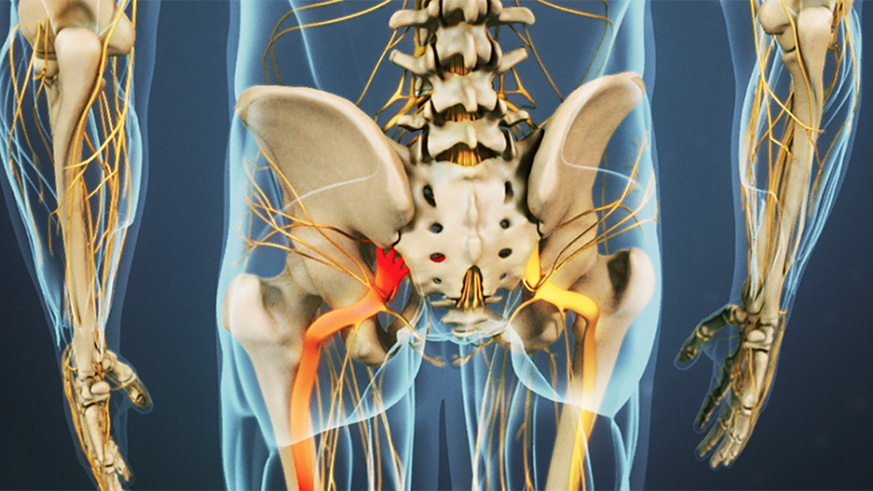

Sciatica is the compression of the sciatic nerve or its roots in any part of its course from the lower back to the buttocks to outer side of the legs and feet.
It causes pain and or paresthesia, that is, abnormal sensations occurring in the legs or feet. The sciatic nerve is the longest nerve in the human body. It starts from the backbone till the foot. During its long course, it is prone to compression or injury at any point.
The most common cause for sciatic nerve compression happens to be a lumbar spondylosis. This is a degenerative change occurring in the elderly, where the disc space between the lumbar vertebrae is reduced and tiny new spicules of bone are formed. Both reduction of the space and the presence of spicules can cause its compression. Herniation of the intervertebral disc can cause sciatica in both young and old. Apart from these, spinal tumours, infections or trauma of any kind, can lead to sciatica. At times there may be spread of cancer to the backbone from any other part of the body. Notably, cancers from the stomach, breast, thyroid, lung, and etcetera, commonly spread to the backbone. These bony metastasis can also precipitate sciatica.
Earliest symptoms may be pain in the lower back which may radiate to the hip, thigh and the lower limb towards the outer side. This pain is typically aggravated by movements, particularly bending from the back or walking or lifting the legs up. If the nerve roots are compressed, pain can also be induced by coughing. Relief is obtained when one stops any of these movements and lies down or sits with legs spread straight.
Along with the pain, one may feel abnormal sensations in the outer side of the thigh and legs. There may be sensation of insects crawling over the legs, or tingling. In severe cases, one may feel numb over the affected part and there may be loss of sensation.
The intensity of the symptoms depends on the part of the nerve compressed. In case of involvement of the nerve roots alone, the pain is localised to the lumber region of the back. In case of affection of the main nerve, pain and paraesthesia can be felt along its entire course.
This condition is easily diagnosed by clinical features. When paraesthesia is induced by elevation of the legs, it confirms the suspicion of sciatica. Other advanced investigations like C.T. scan and MRI are done to know the cause of sciatica. Myelography (visualisation of the spinal cord after injecting a dye) is done in case of suspected tumours of the spinal cord.
The conservative symptomatic treatment of sciatica consists of bed rest on a hard bed with the back kept straight. After the pain is reduced, walking and weight bearing is allowed and increased gradually. One is advised to keep the back straight, well supported and avoid bending. In persons suffering from chronic sciatic pain, a belt is advised to be worn while standing or walking as this helps in easing the pain while sharing some of the weight of the body.
Pain killer tablets or injections are used to diminish the pain. Supplements of vitamin B complex and anti-depressants are used to provide relief from the troublesome paraesthesia. If a definite underlying cause for sciatica is found, surgery is done.
After treatment, when the individual is free from pain, regular exercises to strengthen the back and limb muscles help in further improvement.
If one is prudent to keep the back straight, use a hard bed and do regular exercises, one can prevent sciatica, or minimise its symptoms.
Dr Rachna Pande,
Specialist, internal medicine rachna212002@yahoo.co.uk


